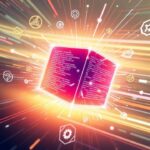The Rise of Self-Supervised Learning: Revolutionizing AI’s Future?
Self-supervised learning is running at full steam in the artificial intelligence (AI) sphere, presenting an exciting landscape of advancements and possibilities. But what exactly is self-supervised learning, and why is it essential to the future of AI? Let’s dive in and explore how this innovative approach is reshaping the way machines learn, and ultimately, how it’s set to revolutionize AI.
1. What is Self-Supervised Learning?
Self-supervised learning is a form of machine learning where the model teaches itself using its input data. Instead of relying on labeled data, which can be time-consuming and expensive to obtain, self-supervised learning leverages the structure within the data itself to create labels on the fly. Think of it as a self-improving loop where the model gets better the more it trains on unstructured data.
1.1 How Does It Differ from Supervised and Unsupervised Learning?
- Supervised Learning: This traditional approach requires labeled data to train models. For example, an image dataset that includes labels indicating whether each image contains a cat or a dog. The model learns to predict the labels based on the input data.
- Unsupervised Learning: This method works with unlabeled data, aiming to identify patterns and structures within the dataset. Clustering algorithms are a classic example, grouping similar data points together without any predefined labels.
- Self-Supervised Learning: This bridges the gap by creating labels from the data itself. For example, in natural language processing, a model might predict the next word in a sentence, using the sentence itself as the basis for generating supervisory signals.
2. Why is Self-Supervised Learning So Exciting?
Self-supervised learning is particularly exciting because it offers a way to train sophisticated models without the need for extensive labeled datasets. This is a game-changer in fields where labeled data is scarce or prohibitively expensive to collect.
2.1 Efficient Use of Data
One of the biggest advantages of self-supervised learning is its efficiency in using data. By generating its own labels, the model can make use of vast amounts of unlabeled data that would otherwise go unused. This means that researchers and developers can train more powerful models with the same amount of data.
Imagine training a model on a huge dataset of natural images. Instead of needing millions of labeled images, you can train the model on the unlabeled images alone, making it adaptable and highly effective.
2.2 Versatility Across Domains
Self-supervised learning isn’t limited to a single type of data. It can be applied across a variety of domains, from computer vision to natural language processing, and even more specialized areas like audio processing and genomics. This versatility makes it a powerful tool for a wide range of applications.
For instance, in computer vision, self-supervised learning can be used to train models to understand the spatial relationships within images. In natural language processing, it can be used to train models to understand the context and semantics of text.
3. How Does Self-Supervised Learning Work?
To understand how self-supervised learning works, let’s break it down into a few key steps:
- Input Data Preparation: The model starts with a large dataset of unlabeled data. This data can be anything from images to text to audio files.
- Pretext Task Creation: The model generates its own labels by creating a pretext task. For example, in image processing, a common pretext task is to predict the next frame in a video sequence. In natural language processing, it might be to predict the next word in a sentence.
- Training: The model trains itself on the pretext task, gradually improving its ability to understand the underlying structure and patterns in the data.
- Fine-Tuning: After the initial training, the model can be fine-tuned on a smaller labeled dataset to perform specific tasks, such as image classification or text translation.
3.1 Example: Image Processing
In image processing, a common self-supervised learning approach is to use image patches. The model might be trained to predict the color of a missing patch based on its surrounding patches. This task helps the model learn to understand the spatial relationships within images.
3.2 Example: Natural Language Processing
In natural language processing, a model might be trained to predict the next word in a sentence. This task helps the model understand the grammatical and semantic structure of language. Once trained, the model can be fine-tuned for more specific tasks, such as sentiment analysis or machine translation.
4. Applications of Self-Supervised Learning
The applications of self-supervised learning are vast and varied. Let’s look at some of the most impactful areas where self-supervised learning is making waves:
4.1 Computer Vision
In computer vision, self-supervised learning is used to train models that can recognize objects, scenes, and actions in images and videos. This technology can be applied in various industries, from retail to healthcare.
- Object Recognition: Imagine a system that can automatically tag products in an online store based on images. Self-supervised learning can help train such models without needing millions of labeled images.
- Medical Imaging: In healthcare, self-supervised learning can be used to train models that analyze medical images, helping doctors diagnose diseases more accurately and efficiently.
4.2 Natural Language Processing
In NLP, self-supervised learning enables models to understand and generate human language. This technology is at the core of virtual assistants, chatbots, and language translation tools.
- Sentiment Analysis: Self-supervised learning can train models to understand the emotional tone in text, which is crucial for customer feedback analysis.
- Machine Translation: By learning from large amounts of text data, models can improve their ability to translate languages accurately.
4.3 Audio Processing
Self-supervised learning can also be used in audio processing to train models that recognize and generate sounds. This technology is used in applications such as speech recognition and sound classification.
- Speech Recognition: By learning from large amounts of audio data, models can improve their ability to transcribe speech accurately.
- Music Generation: Self-supervised learning can train models to generate new musical pieces by learning from existing music.
5. Challenges and Limitations
While self-supervised learning holds great promise, it’s not without its challenges and limitations. Let’s discuss a few of the hurdles researchers are facing:
- Data Quality: The effectiveness of self-supervised learning heavily relies on the quality of the input data. If the data is noisy or poorly structured, the model’s performance can suffer.
- Computational Resources: Training self-supervised models can be computationally intensive, requiring significant resources and time.
- Task-Generalization: While self-supervised models excel at pretext tasks, they may struggle to generalize to tasks that are significantly different from their initial training objectives.
5.1 Overcoming Challenges
Despite these challenges, researchers are continually developing new techniques to enhance the capabilities of self-supervised learning. For instance, transferring models pre-trained on one set of data to new domains, or leveraging advances in hardware and algorithms to reduce computational demands. By addressing these issues, the potential of self-supervised learning can be fully realized.
6. The Future of Self-Supervised Learning
The future of self-supervised learning looks incredibly bright. As research continues to push the boundaries of what’s possible, we can expect to see even more groundbreaking applications and improvements in AI technology.
- Next-Generation Models: Researchers are continually innovating new architectures and training techniques, making self-supervised models even more powerful and versatile.
- Cross-Domain Applications: Self-supervised learning’s ability to learn from one domain and apply it to another opens up exciting possibilities in cross-domain learning and transferability.
- Ethical Considerations: As self-supervised learning becomes more prevalent, addressing ethical concerns related to data privacy, bias, and fairness will be crucial to its responsible development.
6.1 Embracing the Future
Self-supervised learning represents a significant leap forward in AI, offering a new way to train models with minimal labeled data. As we embrace this exciting technology, we’re on the cusp of remarkable advancements that will transform industries and enhance our daily lives.
Conclusion
Self-supervised learning is shaking up the AI world in a big way, offering new opportunities and challenges. By leveraging the inherent structure within unlabeled data, we’re paving the way for more efficient and versatile AI systems. As we continue to explore and innovate, the future of AI looks more promising and exciting than ever. So, let’s roll up our sleeves and dive into this fascinating world of self-supervised learning – who knows what incredible discoveries await us?










